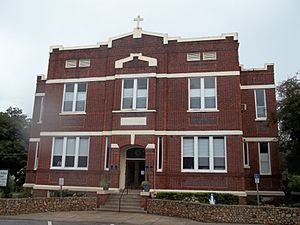Cecilia Morse facts for kids
Charcila Cecilia Moore (born June 3, 1838 – died June 13, 1926) was an important person in Florida history. She helped start Catholic education in the state and was also a citrus farmer. She was born in Anahuac, Texas and studied in Baltimore. Charcila was married to Charles Nathan Morse for 16 years. He passed away in 1881. She is best known for starting St. Anthony Catholic School. This school is the oldest Catholic school in its area and one of the oldest in all of Florida. It's also the oldest school of any kind in Pasco County.
Starting St. Anthony Catholic School
After her husband passed away, Charcila Moore moved to a Catholic community called San Antonio, Florida in 1883. She wanted to try farming there. When she arrived, Mrs. Moore was upset because there was no school for her six children.
The founder of the community, Judge Edmund Dunne, told her that a school would be built later. He said they needed more settlers first. Mrs. Moore famously replied, "The minds of the children now here won't wait for more settlers."
She decided to take action. Mrs. Moore began teaching 14 students, including her own children, right from her home. With help from a visiting priest, Father E.J. Dunne, classes soon moved to the town church on April 29, 1884.
By November of that same year, the first building for St. Anthony of Padua School opened. It was a small wooden building, 12 by 24 feet. Funds for the school were donated by Bishop John Moore. Mrs. Moore continued teaching at St. Anthony until 1889. That's when the Benedictine Sisters arrived to take over the growing school.
One of her first students was a nephew of the town's founder. He later became a famous abbot named Dom Frederic Dunne. Dom Frederic is known for encouraging Thomas Merton to write his famous book, The Seven Storey Mountain.
Life After Teaching
Once the school had enough nuns to teach, Mrs. Moore went back to farming full-time. However, a big problem hit many Florida farmers. The Great Freeze of 1894–95 destroyed all her citrus crops.
Because of this, she had to give her property to nearby St. Leo College. This helped pay for her youngest son's education. With nothing left in San Antonio, she moved her family. After a short time in St. Petersburg, she settled in Tampa. She lived there for the next 26 years.
Charcila had several children. Her son, Francis "Frank" Pius Van Pradellas Morse, was a veteran of World War I. He is buried at Arlington National Cemetery.
Her Final Resting Place
Charcila Cecilia Moore passed away in 1926. Her death happened on June 13, which is the feast day of St. Anthony of Padua. She died in Tampa and is buried in the Catholic part of Oaklawn Cemetery. Five of her seven children are buried around her.
For a long time, no one knew exactly where her grave was. Then, in September 2009, a historian named Father Len Plazewski accidentally found it. He was researching the graves of early Florida priests. Father Plazewski was also an alumnus, meaning a former student, of St. Anthony Catholic School.


